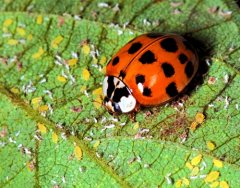Lady Beetles
 There are many species of ladybugs, and while we may view them as beneficial for managing harmful insects in gardens, forests and surrounding landscape, we quickly forget these benefits when the Asian lady beetle enters our homes.
There are many species of ladybugs, and while we may view them as beneficial for managing harmful insects in gardens, forests and surrounding landscape, we quickly forget these benefits when the Asian lady beetle enters our homes.
The coloration of Asian lady beetles varies widely, ranging from mustard yellow to orange and deep red. The number of spots also varies from several to none.
Ladybugs do not carry diseases or sting. Ladybugs are also unable to breed or reproduce indoors. However, when large numbers begin to enter the home they will crawl on walls, windows, and many other surfaces.
Ladybugs become visible to customers twice a year. In the late summer/early fall they can be seen flying to the sides of buildings to seek out over wintering sites. Then as the temperature warms in late winter and early spring, they emerge in large numbers in search of a way outside. They are not mating, but simply seeking out suitable places to spend the winter.
Exclusion is the best policy for managing ladybugs around a structure. The best long-term strategy still involves caulking, sealing and screening. Once ladybugs are established inside of an account there are not a lot of treatment options. Your best friend for these ladybugs when you find them in the fall, winter and early spring is the vacuum cleaner. Caution should be used in their removal so as not to cause staining.
